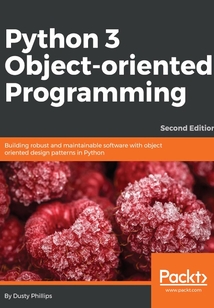目錄(124章)
倒序
- coverpage
- Python 3 Object-oriented Programming Second Edition
- Credits
- About the Author
- About the Reviewers
- www.PacktPub.com
- Support files eBooks discount offers and more
- Introduction to the second edition
- Preface
- What this book covers
- What you need for this book
- Who this book is for
- Conventions
- Reader feedback
- Customer support
- Chapter 1. Object-oriented Design
- Introducing object-oriented
- Objects and classes
- Specifying attributes and behaviors
- Hiding details and creating the public interface
- Composition
- Inheritance
- Case study
- Exercises
- Summary
- Chapter 2. Objects in Python
- Creating Python classes
- Modules and packages
- Organizing module contents
- Who can access my data?
- Third-party libraries
- Case study
- Exercises
- Summary
- Chapter 3. When Objects Are Alike
- Basic inheritance
- Multiple inheritance
- Polymorphism
- Abstract base classes
- Case study
- Exercises
- Summary
- Chapter 4. Expecting the Unexpected
- Raising exceptions
- Case study
- Exercises
- Summary
- Chapter 5. When to Use Object-oriented Programming
- Treat objects as objects
- Adding behavior to class data with properties
- Manager objects
- Case study
- Exercises
- Summary
- Chapter 6. Python Data Structures
- Empty objects
- Tuples and named tuples
- Dictionaries
- Lists
- Sets
- Extending built-ins
- Queues
- Case study
- Exercises
- Summary
- Chapter 7. Python Object-oriented Shortcuts
- Python built-in functions
- An alternative to method overloading
- Functions are objects too
- Case study
- Exercises
- Summary
- Chapter 8. Strings and Serialization
- Strings
- Regular expressions
- Serializing objects
- Case study
- Exercises
- Summary
- Chapter 9. The Iterator Pattern
- Design patterns in brief
- Iterators
- Comprehensions
- Generators
- Coroutines
- Case study
- Exercises
- Summary
- Chapter 10. Python Design Patterns I
- The decorator pattern
- The observer pattern
- The strategy pattern
- The state pattern
- The singleton pattern
- The template pattern
- Exercises
- Summary
- Chapter 11. Python Design Patterns II
- The adapter pattern
- The facade pattern
- The flyweight pattern
- The command pattern
- The abstract factory pattern
- The composite pattern
- Exercises
- Summary
- Chapter 12. Testing Object-oriented Programs
- Why test?
- Unit testing
- Testing with py.test
- Imitating expensive objects
- How much testing is enough?
- Case study
- Exercises
- Summary
- Chapter 13. Concurrency
- Threads
- Multiprocessing
- Futures
- AsyncIO
- Case study
- Exercises
- Summary
- Index 更新時間:2021-07-16 20:44:49
推薦閱讀
- 華為HMS生態與應用開發實戰
- Python從入門到精通(精粹版)
- VMware虛擬化技術
- 程序是怎樣跑起來的(第3版)
- 編程數學
- 深入理解Android:Wi-Fi、NFC和GPS卷
- C語言程序設計
- Node.js:來一打 C++ 擴展
- Android應用案例開發大全(第二版)
- Webpack實戰:入門、進階與調優
- Developing SSRS Reports for Dynamics AX
- Hands-On JavaScript for Python Developers
- 編程改變生活:用Python提升你的能力(進階篇·微課視頻版)
- 軟件體系結構
- OpenCV with Python Blueprints
- Mastering OAuth 2.0
- Python機器學習與量化投資
- 深度學習入門:基于Python的理論與實現
- Groovy 2 Cookbook
- PHP Microservices
- C語言程序設計教程
- C語言王者歸來
- Node.js進階之路
- 自己動手做智能產品:嵌入式JavaScript實現
- jMonkeyEngine 3.0 Cookbook
- Python從入門到精通(微課精編版)
- SAP HANA平臺軟件開發實戰
- C語言程序設計實驗指導(第2版)
- Building Interactive Queries with LINQPad
- 以用戶為中心的軟件設計:打造用戶友好型應用的有效方法和準則


